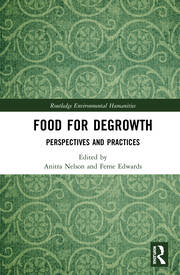
The urgency of addressing climate change cannot be overemphasised. With increasing debates on climate change and planetary sustainability, the concept of degrowth has gained considerable attention among scholars, activists and policymakers. It challenges the practices of economic growth, excessive consumption and centralisation. Instead, it promotes frugality and localisation. The degrowth movement advocates for societies that prioritize societal well-being and is seen as a critique of neo-liberalism and capitalism.
In recent years, academics, particularly social scientists, have paid increasing attention to degrowth. Food for Degrowth: Perspectives and Practices (2021), an edited volume by Anitra Nelson and Ferne Edwards, published by Routledge, is one such attempt. It is a collection of sixteen interdisciplinary essays that address the question of degrowth from different vantage points using food as the entry point. It is argued that –
Nowhere is the crisis of neoliberalism more exposed than in the globalised system of food production (pp. 33).
The book is divided into four parts, preceded by an introduction to degrowth. The first part is an exploration of frugal abundance, the second is on degrowth collectives, the third is on degrowth networks, and the fourth is on degrowth narratives.
Degrowth is intricately connected to decolonisation and decentralisation, and as such, this book explores ‘connections, flows and relationships between centres and peripheries’ (pp. 2). Degrowth is reminiscent of the relationship between food and nature (pp. 215). The degrowth movement emerged in Europe but has no headquarters as such. It celebrates decolonisation, autonomy and collectivisation in the food business, and the rise of the movement has coincided with the emergence of alternative food networks (pp. 3). The objective is to contract production and consumption. The idea is that everyone’s needs will be met simultaneously while achieving ecological sustainability (pp. 198). With an increasing gaze turned against the varied crises raised by neoliberalism, food provisioning, too, has been rethought. Activities like Food Self-Provisioning (FSP) are seen as antithetical to the neo-liberal ideas of capitalism and growth, as Petr Danek and Petr Jehlicka’s article (Chapter 3) shows (pp. 43).
Local knowledge about food has also become an important factor in pushing towards degrowth. Meike Bruckner’s article (Chapter 4) looks at how cultivating and sharing knowledge on African Indigenous Leafy Vegetables (AIVs) by urban women in Nairobi becomes a way of creating a sustainable and solidarity-oriented food system. Multiple recipes are practised by the women for degrowth, where the ingredients are homegrown.
The rise of degrowth collectives like market gardens has played a key role in disseminating information about the movement. The market gardening model connects small farmers directly with local consumer groups and can be seen as a type of FSP (pp. 79). This is another attempt at breaking the hegemony of the centre in the centre-periphery model. Alternate food provisioning models are seen as instrumental for making degrowth possible.
In their article, Diana Szakal and Balint Balazs show how local food cultures have developed and sustained themselves in Hungary (Chapter 9). The urban food system in Hungary is based on local markets and maintained through traditional agricultural practices like community-supported agriculture and seed exchange networks (pp. 116). In recent years, the role of technology has also become instrumental in facilitating the degrowth movement. Ferne Edwards and Ricard Espelt explore the role of digital platforms in this context (Chapter 10). Using both qualitative and quantitative research methods, they examine how new technologies impact food sharing in local communities in Catalonia. Their research shows that digital platforms are feasible in promoting fair trade and cooperation in community-based agriculture through collaborative learning. Technology has made it easier for stakeholders and participants of the degrowth movement to network and share resources.
In the fourth section, the essays are narratives that look at degrowth from varying contexts. In his study of permaculture in Melbourne, Terry Leahy argues how it is difficult to provide food sustainability in the city without using fossil fuels (pp. 209). It is still possible for smaller cities to be sustainable through forms of non-fossil fuel modes of transportation but not in big ones like Melbourne. Thus, practices like permaculture and degrowth become very difficult to promote.
It is also important to recognise that the degrowth movement is still struggling to challenge the capitalist, growth-based models of food provisioning. But the authors have tried to highlight some of the ways in which the idea of degrowth and the movement are operating in different parts of the world. The book’s strength lies in the diversity of its contributors, with a good mix of academics, activists and grassroots workers. While its empirical value is quite strong, I feel the theoretical framework could have been better. Although the relationship between degrowth and other debates like care and sustainability are dealt with in some chapters, there could have been a little more focus on it. Nonetheless, the book sets a tone for more works on degrowth in the future. It can be useful for students working on food sustainability cutting across Sociology, Social Anthropology, Food Studies and Environmental Studies.
It is part of the growing recognition that ‘a global resurgence is underway calling for new principles, approaches and practices to provide a fair, safe and healthy food system for all’ (pp. 141).
